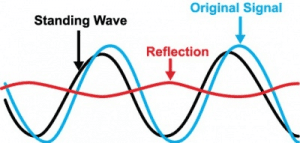What was that?
Ever go to a party and you’re one of the first to arrive? You start a pleasant conversation and before you know it, as attenders start funneling in, find yourself yelling in the ear of the listener “what was that”? The same thing happens
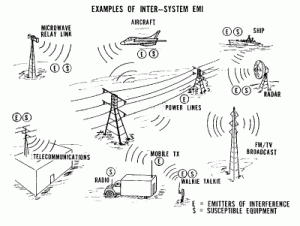
in the unseen world of radio frequency communications. The only fundamental differences being the media, soundwaves vs. electromagnetic waves and the participants, people vs electronic devices. As the number of participants increases, so does the noise level, thus as in the party analogy, you either increase your volume, request them to repeat themselves or wait for a quiet period. Believe it or not, these basic principles form the building blocks of the wireless world we find ourselves in. Whereas volume, repetition and waiting period represent transmitted power, error correction and transmit time slot, additionally frequency spectrum.
Who cares?
As you would expect, considering the broad use and dependency the world has on wireless

communications, the frequency spectrum in which these systems operate would need to be managed by non-commercially based governmental agencies. The two dominant governing bodies are the FCC (US) and ECC (EU). These dictate the allocation and management of this spectrum. The spectrum is allocated based on
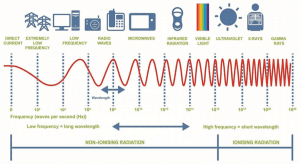
application, propagation distance, atmospheric attenuation, throughput, and directivity to name a few. Spectrum can be reallocated based on technological advancements and is auctioned off periodically. The primary stakeholders for spectrum allocation are military, law enforcement and commercial. The spectrum is split into small segments called bands; each band has specific rules that must be obeyed for these systems to function properly. It is apparently obvious that each stakeholder has a vested interest in the policing and stability of the wireless spectrum.
Me first!
The primary player in the “me first” list will always be military applications considering the role defense has on commerce and governing
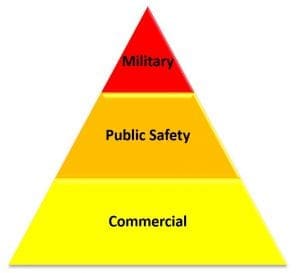
stability. Law enforcement and first responders are essential as well in providing local security and protecting human life and property. And lastly commercial applications, which are the financial bedrock that supports this infrastructure. Although all entities have common interests as it relates to spectrum stability (monitoring) and structure (management), such as system robustness, security and quality of service. Each entity has their emphasis. For example, military might focus on system redundancy and electronic warfare (EW); law enforcement on system redundancy; commercial on competition and cost. Military systems will monitor and analyze the airwaves for traffic, potential threats and adjust accordingly. Whereas law enforcement and first responders may switch to a redundant system during high traffic or system failures. The commercial segment has a vested interest in protecting their markets and coverage areas in order to optimize quality of service and manage cost.
How to?
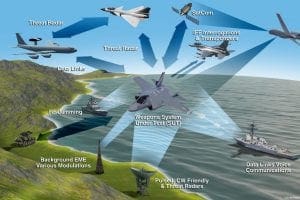
You might be asking yourself, so how do you police the wireless universe? The answer depends on the application. However, all utilize a variation of the same technique, listening (monitoring). The battle theater (Figure 5), is a great example of the diverse monitoring platforms available. You would expect, considering the global reach and tactical nature of the military, all options would be utilized. Such as land based fixed towers, mobile vehicles, sea vessels, satcom and manned and unmanned aircraft. As
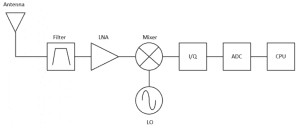
mentioned, the common thread in all these platforms is a receiver system. A receiver is comprised of an antenna, filter, low noise amplifier, mixer, I/Q demod, ADC and CPU (Figure 6). Signals are detected by the antenna, unwanted signals are filtered out, low noise amplifier increases the desired signal level while minimizing signal to noise degradation, mixer combines the signal with local oscillator reducing the frequency of the signal (IF), the signal is split into I/Q baseband waveforms, digitized and processed. One of the many critical elements in the system is the frequency spectrum it needs to operate in (Figure 7). Military applications have the broadest spectrum requirement which puts the burden on the on
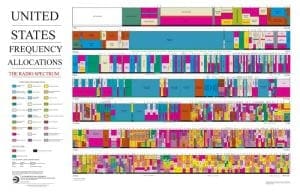
the antenna, input filtering and LNA sections. These system elements are tuned to specific bands (pre downconversion) while everything after (post downconversion) can be software defined (SDR). In order to cover large bandwidths, the pre downconversion section may have several switchable tuned banks while the SDR scans within each sub-band post downconversion. In the military application one or several of the platforms will scan the spectrum looking for activity, identifying friend or foe (IFF) signals; once identified it either manipulates the waveform of the adversary by broadcasting similar signals (spoofing) or adjusts friendly signals as a countermeasure to adversarial attack. Commercial applications typically requiring smaller bandwidth, utilize this similar technique to sample waveforms for data quality, effective radiation pattern EIRP for transmitter power efficiency and to verify the reach of there competition. As the demand for wireless spectrum continues to increase, monitoring and policing will play a critical role in the stability and reliability of our wireless universe.
References
– Figure 1 – http://www.rfiinternational.com/serv02.htm
– PC world – FCC moves to open wireless spectrum to commercial and military uses – By Grant Gross
– Defensesystems.com – Navy continues electronic warfare upgrades for ships – By Kevin McCaney
About NuWaves
NuWaves RF Solutions is a premier supplier of RF and Microwave solutions for Department of Defense (DoD), government, and industrial customers. An RF engineering powerhouse, NuWaves offers a broad range of design and engineering services related to the development and sustainment of key communications, telemetry and electronic warfare systems, as well as a complete line of commercially available RF products. NuWaves’ products include wideband frequency converters, high-efficiency and miniature solid-state power amplifiers and bidirectional amplifiers, high intercept low noise amplifiers and miniature RF filters. NuWaves RF Solutions…Trusted RF Solutions™.
www.nuwaves.com for more information.

